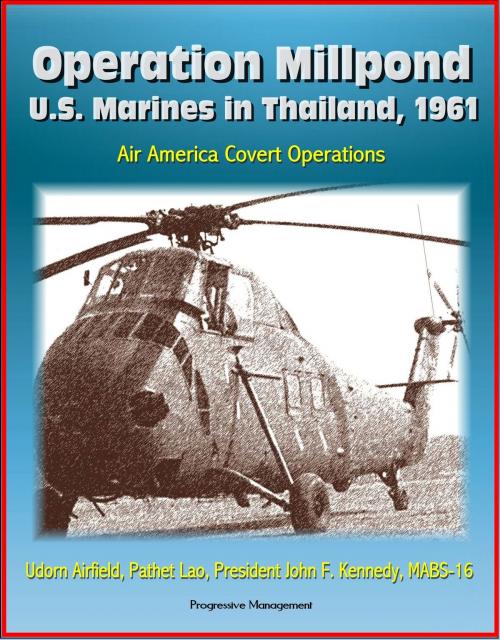Operation Millpond: U.S. Marines in Thailand, 1961 - Air America Covert Operations, Udorn Airfield, Pathet Lao, President John F. Kennedy, MABS-16
Nonfiction, History, Military, Vietnam War, Asian| Author: | Progressive Management | ISBN: | 9781301622559 |
| Publisher: | Progressive Management | Publication: | December 20, 2012 |
| Imprint: | Smashwords Edition | Language: | English |
| Author: | Progressive Management |
| ISBN: | 9781301622559 |
| Publisher: | Progressive Management |
| Publication: | December 20, 2012 |
| Imprint: | Smashwords Edition |
| Language: | English |
This operation highlights the role that the small country of Laos played in the foreign policy calculations of the newly elected U.S. president, John F. Kennedy. Gravely concerned that the Laotian government was in danger of being overwhelmed by a growing Communist insurgency known as the Pathet Lao, President Kennedy took the bold step of deploying Marine Air Base Squadron-16 (MABS-16) to nearby Thailand for the purpose of supporting a collection of helicopters piloted by an organization called Air America. Hollywood later made a movie about Air America, and it is now widely known that it was linked to the Central Intelligence Agency. The Marines of MABS-16 received no such fanfare. Working behind the scenes in austere conditions, MABS-16 gave new meaning to the phrase "in any clime and place." While Operation Millpond may seem like a small thing in comparison with much larger operations that were soon to be conducted by Marines in the Republic of South Vietnam, it nonetheless represents a clear beginning to a growing U.S. military commitment to the region as a whole, one that did not end until the last Marine left the roof of the American embassy in Saigon in 1975.
In early 1961, Communist Pathet Lao military forces were coming dangerously close to taking control of the Southeast Asian country of Laos. A Pathet Lao victory over the Royal Laotian government not only would have lost a pro-Western nation to the Communist Bloc but would have put its neighbors—particularly pro-Western Thailand—at risk. To forestall this possibility, newly elected President John F. Kennedy and his administration decided to measurably increase U.S. support to the Royal Laotian government.
This increased support came in part in the form of a 20-helicopter fleet, flown by civilian pilots and crews employed by Air America. This helicopter force covertly flew Royal Laotian troops, weapons, supplies, and other war materiel in support of the Royal Laotian government's anti-Communist military operations. A major operational deficiency—Air America lacked any aircraft maintenance and flight-line operational and maintenance capability—was resolved by assigning a military organization with the required skills to play a supporting role. Marine Air Base Squadron-16 (MABS-16), located at Marine Corps Air Facility (MCAF) Futema, Okinawa, was assigned the mission. Operations were conducted from a bare-bones airfield located outside of Udorn, a town in northeast Thailand approximately 40 miles south of the Laotian capital of Vientiane.
Introduction * Laos in the Years Following World War II * The Situation in Laos Deteriorates, 1960-61 * President Kennedy Commits U.S. Forces * The Order to Deploy Marine Corps Forces is Issued * MABS-16 is Task Organized for its Mission * The Execute Order * The MABS-16 Mission * The Early Days of Operation Millpond * Your Only Comment Will Be "No Comment" * Aircraft Maintenance and Line Maintenance Operations—The First Weeks * Camp Construction * Logistics * Medical Support * Communications * Morale, Welfare, and People-to-People Programs * Aircraft and Line Maintenance Operations * Epilogue
This operation highlights the role that the small country of Laos played in the foreign policy calculations of the newly elected U.S. president, John F. Kennedy. Gravely concerned that the Laotian government was in danger of being overwhelmed by a growing Communist insurgency known as the Pathet Lao, President Kennedy took the bold step of deploying Marine Air Base Squadron-16 (MABS-16) to nearby Thailand for the purpose of supporting a collection of helicopters piloted by an organization called Air America. Hollywood later made a movie about Air America, and it is now widely known that it was linked to the Central Intelligence Agency. The Marines of MABS-16 received no such fanfare. Working behind the scenes in austere conditions, MABS-16 gave new meaning to the phrase "in any clime and place." While Operation Millpond may seem like a small thing in comparison with much larger operations that were soon to be conducted by Marines in the Republic of South Vietnam, it nonetheless represents a clear beginning to a growing U.S. military commitment to the region as a whole, one that did not end until the last Marine left the roof of the American embassy in Saigon in 1975.
In early 1961, Communist Pathet Lao military forces were coming dangerously close to taking control of the Southeast Asian country of Laos. A Pathet Lao victory over the Royal Laotian government not only would have lost a pro-Western nation to the Communist Bloc but would have put its neighbors—particularly pro-Western Thailand—at risk. To forestall this possibility, newly elected President John F. Kennedy and his administration decided to measurably increase U.S. support to the Royal Laotian government.
This increased support came in part in the form of a 20-helicopter fleet, flown by civilian pilots and crews employed by Air America. This helicopter force covertly flew Royal Laotian troops, weapons, supplies, and other war materiel in support of the Royal Laotian government's anti-Communist military operations. A major operational deficiency—Air America lacked any aircraft maintenance and flight-line operational and maintenance capability—was resolved by assigning a military organization with the required skills to play a supporting role. Marine Air Base Squadron-16 (MABS-16), located at Marine Corps Air Facility (MCAF) Futema, Okinawa, was assigned the mission. Operations were conducted from a bare-bones airfield located outside of Udorn, a town in northeast Thailand approximately 40 miles south of the Laotian capital of Vientiane.
Introduction * Laos in the Years Following World War II * The Situation in Laos Deteriorates, 1960-61 * President Kennedy Commits U.S. Forces * The Order to Deploy Marine Corps Forces is Issued * MABS-16 is Task Organized for its Mission * The Execute Order * The MABS-16 Mission * The Early Days of Operation Millpond * Your Only Comment Will Be "No Comment" * Aircraft Maintenance and Line Maintenance Operations—The First Weeks * Camp Construction * Logistics * Medical Support * Communications * Morale, Welfare, and People-to-People Programs * Aircraft and Line Maintenance Operations * Epilogue















